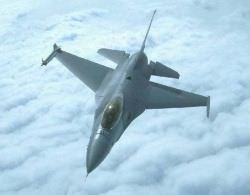|
The Interservice/Industry
Training, Simulation and Education Conference (I/ITSEC)
by Eric Larson, LT USN January 10th, 2000 |
||||
|
So, at this point I was asking, "What have we got so far?" The cockpit wasn't true to life - so this isn't a procedures trainer. The visuals are dated, to say the least, so we're not aiming at a mission trainer. I decided to test out the flight model. From my relatively moderate experience in flight sims (harkening back to the early MS Flight Simulator days in high school), I attacked the high-G and low-airspeed realms. Immediately, I was struck with a distinct sense of how heavy the controls were. I couldn't just crank the bird over, I had to push hard on the stick to effect a roll, consciously exert to get G and leveling out wasn't as simple as at home on the trusty (but aging) P200MMX. In fact, it required two-hands to get the stick all the way back for full elevator deflection! Interesting... To explore the high-G arena I climbed to about 6k ft, rolled inverted to about 40-deg nose down, rolled upright, selected full burner, built up as much speed as the altitude would allow, leveled out at ~1000-ft and commenced a level, max-burner turn. I can't quite remember the airspeed I entered the turn at (I was still getting used to the "feel" and just basic control was an issue and thus had more of my attention). But I do remember checking sustaining 5.8-g and about 380kts. Seems pretty good. Then came the low-airspeed regime. Popping boards, pulling throttles to idle and the stick full aft, I assaulted the low-speed envelope. I have read about the Hornet's legendary low-speed handling characteristics and decided to see for myself how much the "Echo" inherited from the "Charlie." With the attitude exceeding 60-deg nose up and airspeed falling through 280kts and below, aileron authority was *severely* reduced. Full lateral stick deflection yielded a torturously slow roll rate. On the way to rolling inverted the nose started to yaw sickly toward the Earth, beginning a lateral back and forth see-saw effect before I could get pointed down. Airspeed was taking a long time to build up, even at max burner, and it didn't appear I had control. If I did have control, it wasn't much. I began fearing another "penetration," but was able to manage a pull-out. Now to play with the rudder! A level acceleration and another pull towards the blue with min throttle selected and full aft stick to keep the nose up. This time with airspeed dropping through 250kts roll was initiated with pro-rudder with outstanding results. I was rewarded with a near instantaneous flip of the attitude ladder and began a controlled pitch toward the negative vertical direction. LOT'S of rudder authority at high-alpha, low-airspeed. Amazing. |
 Leveled out below 500ft, gained airspeed to ~350kts, pulled up again and reduced power, this time we'd try opposite rudder at high-alpha, low-airspeed. And, as in the previous experiment, it wasn't hard to get pointed downward. Again, plenty of rudder authority. The aircraft rolled heartily in the direction of the rudder displacement. With those very interesting results I moved on to weapons modeling. Couldn't exactly get the hang of the HOTAS concept right off the bat, but I knew weps were on the thumb switch on the joystick. Confirming in the HUD that I had an AMRAAM called up, I hosed one off. Hmmm. Pretty poor. It wasn't exactly eye watering, guys. Definietely no alpha blending or other modern techniques for making sims beilievable. Commercial sims passed this stage a long time ago. Calling up the AIM-9 and letting go resulted in the exact same graphics! Disappointing. But frankly, at this stage, I wasn't expecting much graphically. No one was pounding on the wall, but I'd taken up a good 20 mins at the end of the crew's day so I decided to call it quits right about there. So, in the end - I wasn't too impressed. The visuals were horrid, no WEAX, multi-play was limited to 4, the cockpit was "simulated" to say the least, HOTAS was dead-on, that's for sure, weapons were generic and the 40-deg field-of-view was un-natural and limiting yet I was able to acclimate myself to it. The flight model - I have a feeling this is where this simulator shines. Never having actually flown an -18E, though, could leave the FM as an unknown. But it seemed good enough to me and taught me something more about the low-airspeed/high-alpha handling characteristics of the bird. Go to Part III
|
|||
|
Copyright © 1997 - 2000 COMBATSIM.COM, INC. All Rights Reserved. Last Updated January 10th, 1999 |
||||
